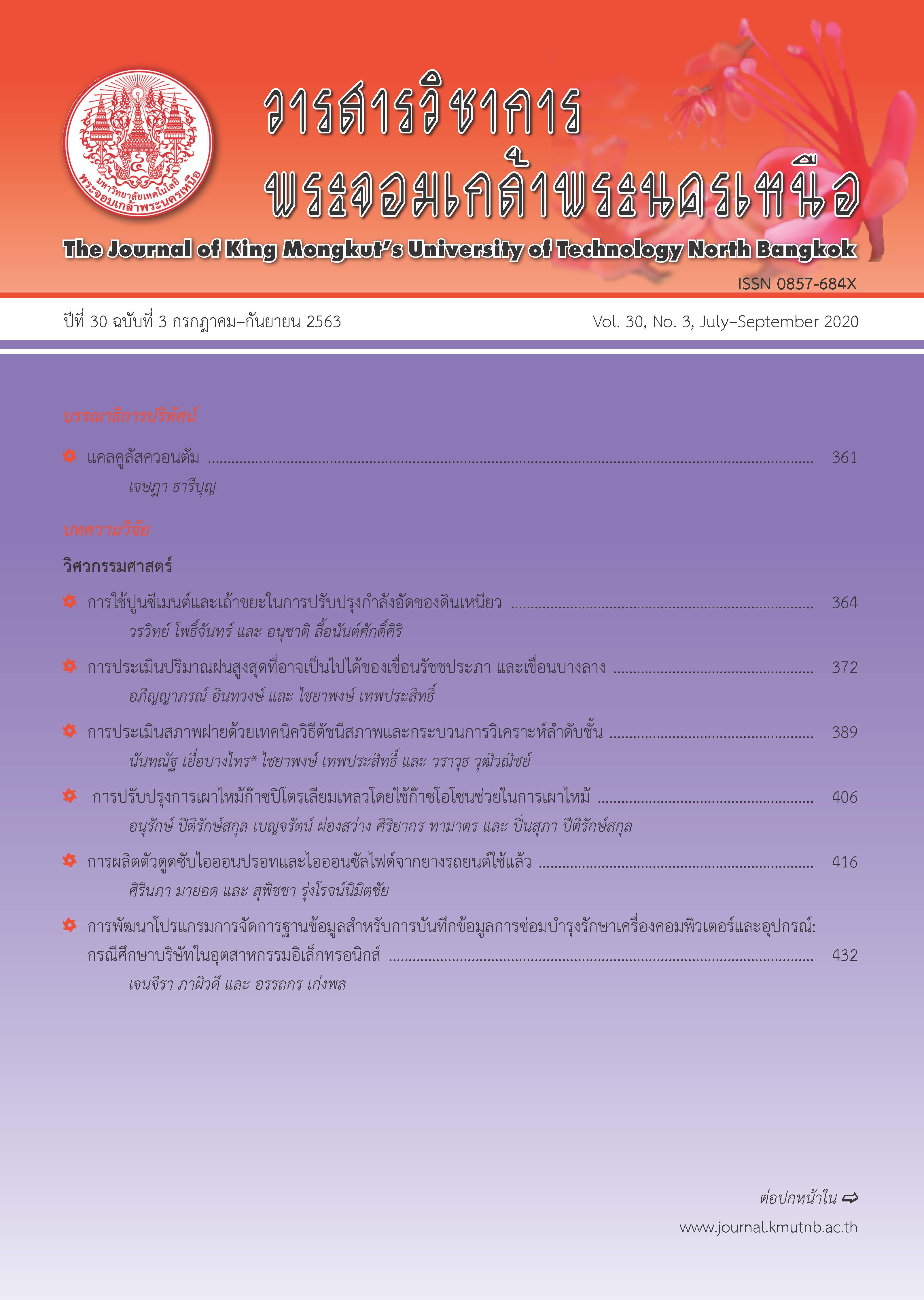การใช้ปูนซีเมนต์และเถ้าขยะในการปรับปรุงกำลังอัดของดินเหนียว
Main Article Content
บทคัดย่อ
บทความนี้ศึกษาอิทธิพลของตัวแปรควบคุม (ปริมาณความชื้น ปริมาณปูนซีเมนต์ ปริมาณเถ้าหนักจากการเผาขยะ และอายุบ่ม) ต่อกำลังอัดของดินเหนียวผสมปูนซีเมนต์และเถ้าขยะ โครงการนี้แสดงให้เห็นถึงความเป็นไปได้ในการแทนที่ปูนซีเมนต์ด้วยเถ้าขยะเพื่อเพิ่มกำลังอัดของดินเหนียว กำลังอัดของดินเหนียวผสมซีเมนต์มีค่าเพิ่มขึ้นตามปริมาณเถ้าขยะ เนื่องจากเถ้าขยะช่วยให้อนุภาคของดินเหนียวและปูนซีเมนต์กระจายตัวและสัมผัสน้ำได้มากขึ้น ทำให้เกิดปฏิกิริยาไฮเดรชันได้ดีขึ้นในทุกอัตราส่วนผสมระหว่างปูนซีเมนต์และน้ำ การผสมเถ้าขยะในปริมาณร้อยละ 20 ของปูนซีเมนต์ ให้กำลังอัดสูงสุด กำลังอัดของดินเหนียวผสมซีเมนต์เถ้าขยะที่อัตราส่วนผสมต่างๆ สามารถประมาณได้โดยอาศัยพารามิเตอร์ Clay-water/Cement Ratio ร่วมกับตัวแปรปริมาณปูนซีเมนต์เทียบเท่า จากการศึกษาพบว่า ที่อายุต่างๆ เถ้าขยะมีประสิทธิภาพเทียบเท่ากับ 0.80 เท่าของปูนซีเมนต์ สำหรับทุกอัตราส่วนผสมระหว่างปริมาณความชื้น ปริมาณปูนซีเมนต์ และปริมาณเถ้าขยะ
Article Details
บทความที่ลงตีพิมพ์เป็นข้อคิดเห็นของผู้เขียนเท่านั้น
ผู้เขียนจะต้องเป็นผู้รับผิดชอบต่อผลทางกฎหมายใดๆ ที่อาจเกิดขึ้นจากบทความนั้น
เอกสารอ้างอิง
[2] P. Sancharoen, “Utilization of municipal solid waste incinerator fly ash as a partial cement replacement on concrete,” M.S. thesis, Departmental Program in Environmental Management Graduate School, Chulalongkorn University, Bangkok, 2003 (in Thai).
[3] N. Chusilp, S. Ngarmkham, and M. Anusiri “Effects of municipal waste ash on the durability and mechanical properties of concrete,” in Proceedings of the 22nd National Convention on Civil Engineering, Nakhon Ratchasima, Thailand, vol. 2, pp. 91–96, 2017 (in Thai).
[4] A. Suddeepong, R. Rachan, and S. Horpibulsuk, “Equivalent cement content-A new parameter for analysis of strength delelopment in blended cement admixed clay,” presented at the 14th National Convention on Civil Engineering. Nakhon Ratchasima, Thailand, 2009 (in Thai).
[5] W. Phojan and S. Horpibulsuk, “Analysis of strength development blended cement admixed saline soil,” KKU Enguneering Journal, vol. 38, no. 1, pp. 27–34, 2011 (in Thai).
[6] S. Horpibulsuk, R. Racha, and Y. Raksachon, “Role of fly ash on strength and microstructure development in blended cement stabilized silty clay,” Soils and Foundations, vol. 49, no. 1, pp. 85–98, 2009.
[7] S. Horpibulsuk, N. Miura, and T. S. Nagaraj, “Assessment of strength development in cement-admixed high water content clays with Abrams’ law as a basis,” Geotechnique, vol. 53, no. 4, pp. 439–444, 2003.
[8] S. Horpibulsuk and N. Miura, “A new approach for studying behavior of cement stabilized clays,” in Proceedings of the 15th International Conference on Soil Mechanics and Geotechnical Engineering, Istanbul, Turkey, vol. 3, pp. 1759–1762, 2001.
[9] N. Miura, S. Horpibulsuk, and T. S. Nagaraj, “Engineering behavior of cement stabilized clay at high water content,” Soil and Foundation, vol. 41, no. 5, pp. 33–45, 2001.

